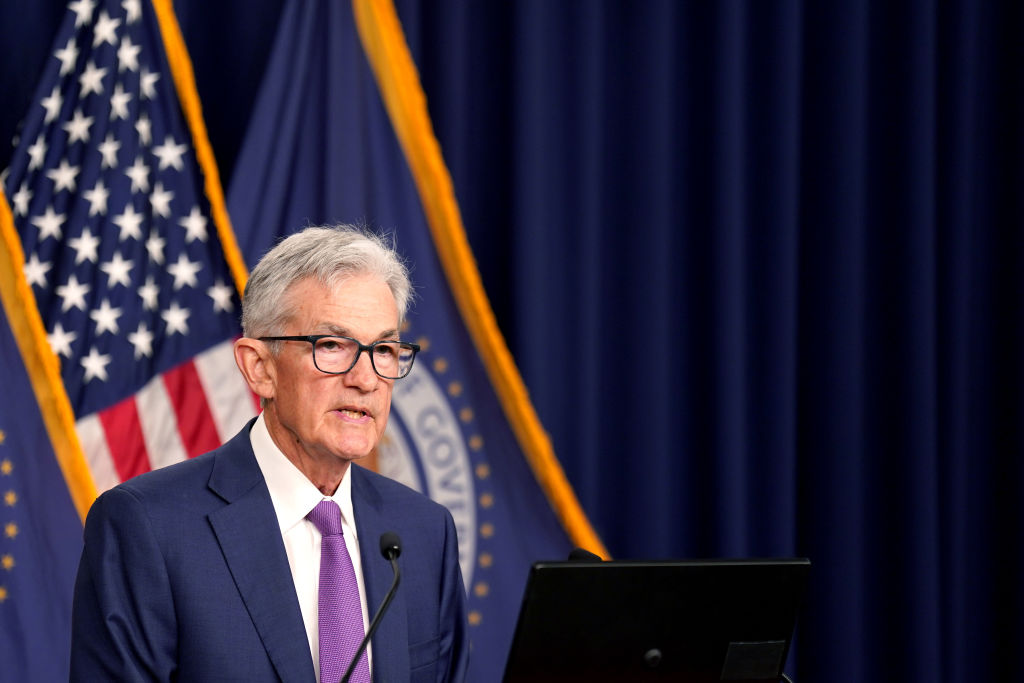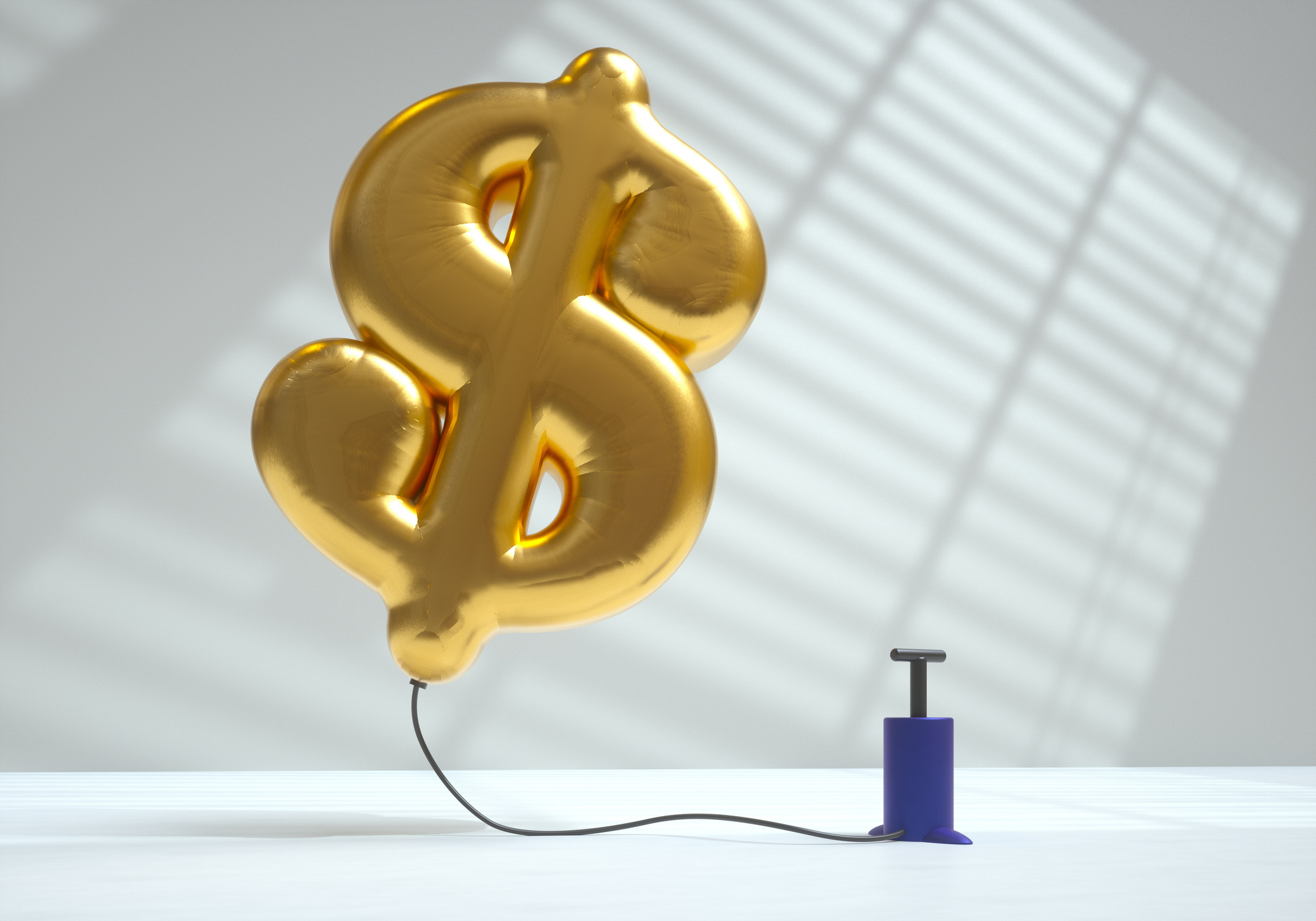Federal Reserve Meeting: Kiplinger Analysis and Commentary
The Fed held rates steady, as expected. Kiplinger experts walk through the announcement.


The Federal Reserve wrapped up its regularly scheduled two-day meeting with a policy statement and Chair Jerome Powell's press conference. No one expected the central bank to bring rates down from a 23-year high, and if anything, markets braced for a "higher-for-longer" message from the Fed.
The central bank's Federal Open Market Committee (FOMC) left interest rates unchanged at its last meeting in March, and indications this time around, including from the latest economic reports, pointed to more of the same with inflation staying sticky and growth coming more slowly.
Here, Kiplinger investing and economic experts provided live guidance and commentary on the Fed meeting and what it could mean for you going forward. All times posted are in Eastern.
From just $107.88 $24.99 for Kiplinger Personal Finance
Become a smarter, better informed investor. Subscribe from just $107.88 $24.99, plus get up to 4 Special Issues

Sign up for Kiplinger’s Free Newsletters
Profit and prosper with the best of expert advice on investing, taxes, retirement, personal finance and more - straight to your e-mail.
Profit and prosper with the best of expert advice - straight to your e-mail.
General analysis and response
Kiplinger's interest rates outlook - 5:00 p.m.
Fed Chair Jerome Powell sounded a bit less dour at his May 1 press conference, which had a brief but positive effect on financial markets. However, he also didn’t suggest an interest rate cut might happen anytime soon.
Read on for Kiplinger's interest rates outlook, detailing what we expect for Treasuries, mortgage rates, and other short-term interest rates, and thank you for joining us today.
- David Payne, staff economist, Kiplinger Letter
What analysts say about the Fed meeting - 4:18 p.m.
Equity investors largely celebrated the Fed announcement, which left interest rates unchanged for a sixth straight meeting.
"After seeing disinflationary momentum stall in recent months, investors had braced themselves for a more hawkish tone from the Fed at this meeting," says Adam Phillips, managing director of investments at EP Wealth Advisors. "However, the prepared statement and press conference that followed painted a more optimistic view of the current economic backdrop and led to a sharp rally in both equities and fixed income."
Read on for more analyst commentary on the Fed meeting.
- Dan Burrows, senior investing writer, Kiplinger Digital
Eric Diton, president and managing director of The Wealth Alliance, had some memorable words, saying: "There are two groups of people: those who don't know where interest rates are going, and those who don't know that they don't know where interest rates are going. Powell is in the first camp."
Indeed, most of Powell's answers boiled down to, "I don't know and I don't want to try to predict, but I am hoping inflation comes down pretty soon so you people will get off my back."
- Jim Patterson, managing editor, Kiplinger Letter
The market's response to the Fed - 4:08 p.m.
Powell's relatively dovish take on interest rates sent all three indexes up roughly 1%, but the enthusiasm didn't last long. At the close, the Dow was up 0.2% at 37,903, while the S&P 500 (-0.3% at 5,018) and the Nasdaq (-0.3% at 15,605) were back in negative territory.
- Karee Venema, senior investing editor, Kiplinger Digital
Read more: Stock Market Today: Stocks Pop Then Drop After Fed Meeting
Impact for savers and mortgages
What the Fed's announcement means for savers - 3:52 p.m.
While would-be homebuyers are struggling, at least their down payment money can be growing at decent rates if they know what a high-yield savings account is.
Many people have been enjoying the safe, high rates on high-yield savings, money market and CD accounts, including some still over 5%. Read on for what the Fed's rate pause means for savings.
And if you are in the market for an account, take a look at these:
- Best No-Fee High-Yield Savings Rates
- Best High Yield Savings Accounts
- Alexandra Svokos, senior editor, Kiplinger Digital
What the Fed's announcement means for the housing market - 3:41 p.m.
Those looking to buy a home have been crunched by the skyrocketing (and plateaued) rates. First-time homebuyers have been especially hit hard after missing out on the low mortgage rates seen in the early 2020s. Many would-be sellers are holding out as they want to hold onto their own low mortgage rates, keeping supply in the housing market low.
Read on for more on what the Fed announcements means for the housing market, but know that those hoping for lower mortgage rates in the near future are going to have to hold out for longer. Does it bring any comfort to know you're not alone?
And if you're in the market despite the scary rates (good for you), you can take a look here:
- Find The Best 30-Year Mortgage Rates
- Alexandra Svokos, senior editor, Kiplinger Digital
Read more: What You Can Negotiate When Buying a Home
Stock market reacts as Powell speaks - 3:34 p.m.
Stocks remained relatively unmoved by the Fed's policy statement but shot up after Powell put the kibosh on more rate hikes. With less than 30 minutes left in today's session, the Dow is up 1.3%, the S&P 500 has added 1.0%, and the Nasdaq is 1.4% higher.
- Karee Venema, senior investing editor, Kiplinger Digital
Read more: How Interest Rates Impact Stock Prices
Powell speech summary
Powell's Fed meeting speech summary - 3:30 p.m.

Powell noted that the Fed was pleasantly surprised that the labor market has stayed so strong, despite the rapid pace of rate increases the central bank enacted in 2022 and 2023. Now, he’s not concerned that monetary policy is so tight that it threatens a significant increase in unemployment. He said that the unemployment rate could tick up by a few tenths of a percentage point without spooking the Fed. He would need to see a broader weakening in the labor market before considering cutting rates to support economic growth.
But overall, he struck a somewhat more dovish tone than in his last press conference. He noted that the Fed remains committed to bringing inflation down to 2%, and expressed confidence that it will succeed in doing so. He didn’t dwell on the risk of inflation staying too high for too long. That seems to still leave the door open to at least one interest rate cut later this year.
- Jim Patterson, managing editor, and David Payne, staff economist, Kiplinger Letter
Powell denies elections influence decisions - 3:15 p.m.
Asked about if the swiftly approaching presidential election will have an impact on the Fed's rate decisions this year, Powell firmly states it will not, saying the Fed only focuses on the economy and doesn't care about political events. This goes against what some have generally postulated, that the Fed is wary of cutting rates in the lead-up to an election.
"Read all the transcripts. We never talk about elections," Powell says.
- Alexandra Svokos, senior editor, Kiplinger Digital
Powell answers question on 'stagflation' - 3:01 p.m.
Powell brushed off concerns about stagflation, the combination of high inflation and weak economic growth, when asked if he was concerned about weaker GDP growth in the first quarter. He says growth is healthy and that the Fed will bring inflation back down to 2%.
"I don't see the 'stag-' or the '-flation,'" he said.
(This is about as funny as Fed chairs get.)
- Jim Patterson, managing editor, Kiplinger Letter
Read more: What Is Stagflation?
Powell on the labor market and inflation - 2:56 p.m.
Powell is more worried about wage increases than the strength of the labor market itself. That means if wage growth slows, Powell would be OK with high levels of hiring.
But the economy has still been running hot, so it will take longer to be sure inflation is coming down, although he believes inflation will come down eventually. He seems to believe that they will see that sometime this year.
- David Payne, staff economist, Kiplinger Letter
Powell's stance - 2:43 p.m.

Powell is citing a cooling labor market (job openings, quits, other surveys), but saying the labor market is still strong as a reason for not cutting rates.
He interprets the current Fed policy as working in being restrictive. That implies at least no rate hikes — and indeed, he said straight out a hike is unlikely.
- David Payne, staff economist, Kiplinger Letter
Stocks really liked that.
- Karee Venema, senior investing editor, Kiplinger Digital
Powell begins speaking - 2:31 p.m.
First, Powell will review the statement and the decision made.
- David Payne, staff economist, Kiplinger Letter
Fed statement analysis
What we see in the statement - 2:16 p.m.
As expected, Fed Chair Jerome Powell and the rest of the Federal Open Market Committee decided not to cut interest rates because of the recent lack of progress toward the central bank’s 2% inflation target. In a statement, the Fed said it needs greater confidence that progress is being made on reducing inflation, without defining, exactly, what that would look like. Expect Powell’s choice of emphasis in his afternoon press conference to clarify this question somewhat.
Also, the Fed is reducing the pace at which it shrinks its portfolio of Treasury bonds by $35 billion per month, which is a slightly larger step than we expected. That move is probably a prerequisite before any actual cut in the Fed’s benchmark interest rate, but it doesn’t mean a rate cut is likely anytime soon.
- David Payne, staff economist, Kiplinger Letter
Read more: Treasury Bills vs Treasury Bonds: Know the Difference
Key lines from the Fed statement - 2:10 p.m.
These are the key sentences from the Federal Reserve's May 1 statement:
- "In recent months, there has been a lack of further progress toward the Committee's 2 percent inflation objective."
- "The Committee does not expect it will be appropriate to reduce the target range until it has gained greater confidence that inflation is moving sustainably toward 2 percent."
- "Beginning in June, the Committee will slow the pace of decline of its securities holdings by reducing the monthly redemption cap on Treasury securities from $60 billion to $25 billion."
- David Payne, staff economist, Kiplinger Letter
Fed holds rates steady - 2:00 p.m.

As expected, the Fed announced it is keeping rates steady.
The press release stated: "Recent indicators suggest that economic activity has continued to expand at a solid pace. Job gains have remained strong, and the unemployment rate has remained low. Inflation has eased over the past year but remains elevated. In recent months, there has been a lack of further progress toward the Committee’s 2 percent inflation objective."
- Alexandra Svokos, senior editor, Kiplinger Digital
Investor feelings on rates
How investors feel about the upcoming Fed announcement - 1:25 p.m.
This is generally a bummer for equity investors, who pretty much always want lower interest rates. As Warren Buffett, chairman and CEO of Berkshire Hathaway (BRK.B), likes to say: "Interest rates are like gravity in valuations. If interest rates are nothing, values can be almost infinite. If interest rates are extremely high, that's a huge gravitational pull on values."
There's a lot going on in that sentence, so let's just take away one thing as it pertains to share prices. When interest rates go up, a corporation's cost of capital goes up too. (Companies, especially smaller ones, tend to issue a lot of shorter-term floating rate debt.) This is important because a higher cost of capital today equals a lower return on that capital tomorrow.
There's a lot more we could get into. For example, lower rates also make for cheaper margin debt (a cost of capital), which can also be supportive of stocks.
But the bottom line remains the same: equity investors – like most folks – love cheap money. Here's Uncle Warren again: "Interest rates are to asset prices like gravity is to the apple."
In other words, rate cuts make stocks go up.
That's a big reason why the S&P 500 gained more than 25% between the October low and the mid-March high. Traders and investors were betting on a series of cuts. Stocks stumbled in April largely because cuts started coming off the table.
The fact that borrowing costs won't be getting cheaper with today's Fed statement should already be reflected in share prices. That's why Fed Chair Jerome Powell's 2:30 pm press conference will be the real star of Wednesday's central bank show. After all, markets are desperate for clarity on the Fed's rate-cut schedule. If markets move on Fed day, it will likely be because of something Powell says after 2:30 pm.
- Dan Burrows, senior investing writer, Kiplinger Digital
Read more: How Interest Rates Impact Stock Prices
What to look for in the press conference - 12:20 p.m.
As markets await the Federal Reserve’s decision on interest rates later today, here are the key things to look for in Fed Chair Jerome Powell’s press conference:
1. Inflation has not shown much improvement recently. Powell will claim to be resolute in fighting it, and in following the data. But, will Powell hint that he thinks there will be enough of an improvement in upcoming inflation data to allow a rate cut later this year, or is he adamant about waiting to see solid evidence that price pressures are easing before the Fed acts?
2. Will the Fed take the widely anticipated step of slowing the pace of its balance sheet reduction by keeping more of its portfolio of Treasury and mortgage-backed securities? Powell used the word “soon” when asked about this at his last press conference. Keeping more securities on its balance sheet is a likely preliminary before any actual Fed rate cut.
3. If the Fed does take this step, what rationale will Powell offer if he also says that inflation hasn’t improved yet? Any form of looser monetary policy could be hard to square with the recent run of hotter-than-expected inflation reports.
- David Payne, staff economist, Kiplinger Letter
Read more: Kiplinger's Economic Calendar for This Week
Mid-day stock market check-in - 11:37 a.m.

Stocks are mixed midday as investors sift through a packed earnings calendar ahead of this afternoon's Fed announcement. The Dow is outperforming, up 0.3% at last check, as Amazon.com (AMZN) gains on solid first-quarter results. The Nasdaq and S&P 500 are both in the red, though, as Advanced Micro Devices (AMD) sinks on disappointing Q1 gaming revenue.
Today's weakness follows Monday's sharp selloff for the broad market, which closed out a weak April for stocks.
"A pullback was not unhealthy or unexpected, but the stubborn inflation and deteriorating consumer data are sources of concern," says Mark Hackett, chief of investment research at Nationwide. The market continues to face several hurdles, including today's Fed meeting, which should "provide clues on whether the drawdown has legs," he adds.
- Karee Venema, senior investing editor, Kiplinger Digital
Will we get a rate cut at all this year? - 11:20 a.m.
The CME FedWatch Tool now shows futures markets put the most likely scenarios as just one or two quarter-point cuts by the end of the year. And even that would likely require significant progress on the Fed’s goal of bringing inflation down to near 2%.
Recent inflation data are running well above that level. If the inflation data don’t cooperate soon, the odds of even one or two interest-rate cuts could take a big hit.
- David Payne, staff economist, Kiplinger Letter
Read more: How Inflation, Deflation and Other 'Flations' Impact Your Stock Portfolio
Why expectations for a rate cut are low - 10:45 a.m.
Heading into 2024, market participants expected as many as seven quarter-point cuts to the short-term federal funds rate. As recently as March, the central bank's rate-setting group known as the Federal Open Market Committee (FOMC) signaled three cuts before the end of the year.
But, my, have times changed since the Fed's last meeting.
The economic data have been mixed, to put it charitably. A series of stubbornly high inflation prints, indications of slower economic growth and a robust labor market have pushed back the timing – and probably number – of rate cuts. A few economists and strategists are questioning the need for lower rates at all.
"The acceleration in [Tuesday's] Employment Cost Index (ECI) supports the narrative that the last leg down in inflation is going to be slow and uneven and reinforces our call for the Fed to remain on hold until September," Jay Hawkins, senior economist at BMO Capital Markets, said Tuesday.
Although, a May 1 rate cut was never considered much of a possibility. As of April 30, futures traders assigned a 99.5% probability to the Fed standing pat on rates today, up from 90% a month ago, according to CME Group's FedWatch Tool.
- Dan Burrows, senior investing writer, Kiplinger Digital
Related Content
Profit and prosper with the best of Kiplinger's advice on investing, taxes, retirement, personal finance and much more. Delivered daily. Enter your email in the box and click Sign Me Up.

Dan Burrows is Kiplinger's senior investing writer, having joined the publication full time in 2016.
A long-time financial journalist, Dan is a veteran of MarketWatch, CBS MoneyWatch, SmartMoney, InvestorPlace, DailyFinance and other tier 1 national publications. He has written for The Wall Street Journal, Bloomberg and Consumer Reports and his stories have appeared in the New York Daily News, the San Jose Mercury News and Investor's Business Daily, among many other outlets. As a senior writer at AOL's DailyFinance, Dan reported market news from the floor of the New York Stock Exchange.
Once upon a time – before his days as a financial reporter and assistant financial editor at legendary fashion trade paper Women's Wear Daily – Dan worked for Spy magazine, scribbled away at Time Inc. and contributed to Maxim magazine back when lad mags were a thing. He's also written for Esquire magazine's Dubious Achievements Awards.
In his current role at Kiplinger, Dan writes about markets and macroeconomics.
Dan holds a bachelor's degree from Oberlin College and a master's degree from Columbia University.
Disclosure: Dan does not trade individual stocks or securities. He is eternally long the U.S equity market, primarily through tax-advantaged accounts.
- David PayneStaff Economist, The Kiplinger Letter
- Karee VenemaSenior Investing Editor, Kiplinger.com
-
 Are T-Mobile's Prepaid Perks a Home Run or a Strikeout?
Are T-Mobile's Prepaid Perks a Home Run or a Strikeout?T-Mobile's prepaid lineup promises MLB.TV, T-Mobile Tuesdays and hotspot data. But do the perks make it worth switching?
-
 Verizon Home Internet Is Offering Free Tech to New Customers
Verizon Home Internet Is Offering Free Tech to New CustomersVerizon’s latest home-internet promotion includes free tech, but the real savings depend on pricing, speed needs and how long you stay.
-
 Retirees in These 7 States Could Pay Less Property Taxes Next Year
Retirees in These 7 States Could Pay Less Property Taxes Next YearState Taxes Retirement property tax bills could be up to 65% cheaper for some older adults in 2026. Do you qualify?
-
 The November CPI Report Is Out. Here's What It Means for Rising Prices
The November CPI Report Is Out. Here's What It Means for Rising PricesThe November CPI report came in lighter than expected, but the delayed data give an incomplete picture of inflation, say economists.
-
 5 Smart Things to Do With Your Year-End Bonus, From a Financial Professional
5 Smart Things to Do With Your Year-End Bonus, From a Financial ProfessionalAfter you indulge your urge to splurge on a treat, consider doing adult things with the extra cash, like paying down debt, but also setting up a "fun fund."
-
 Are You a Gen X Investor? Here's How You Can Protect Your Portfolio From an AI Bubble
Are You a Gen X Investor? Here's How You Can Protect Your Portfolio From an AI BubbleAmid talk of an AI bubble, what's the best course of action for investors in their 50s and 60s, whose retirement savings are at risk from major market declines?
-
 Hey, Retirees: Put Your Charitable Gifts in a Donor-Advised Fund (and Enjoy Your Tax Break)
Hey, Retirees: Put Your Charitable Gifts in a Donor-Advised Fund (and Enjoy Your Tax Break)A donor-advised fund is a simple (really!), tax-smart strategy that lets you contribute a large, tax-deductible gift now and then distribute grants over time.
-
 Nasdaq Sinks 418 Points as Tech Chills: Stock Market Today
Nasdaq Sinks 418 Points as Tech Chills: Stock Market TodayInvestors, traders and speculators are growing cooler to the AI revolution as winter approaches.
-
 The Rule of Compounding: Why Time Is an Investor's Best Friend
The Rule of Compounding: Why Time Is an Investor's Best FriendDescribed as both a "miracle" and a "wonder," compound interest is simply a function of time.
-
 If You're a U.S. Retiree Living in Portugal, Your Tax Plan Needs a Post-NHR Strategy ASAP
If You're a U.S. Retiree Living in Portugal, Your Tax Plan Needs a Post-NHR Strategy ASAPWhen your 10-year Non-Habitual Resident tax break ends, you could see your tax rate soar. Take steps to plan for this change well before the NHR window closes.
-
 Stocks Chop as the Unemployment Rate Jumps: Stock Market Today
Stocks Chop as the Unemployment Rate Jumps: Stock Market TodayNovember job growth was stronger than expected, but sharp losses in October and a rising unemployment rate are worrying market participants.